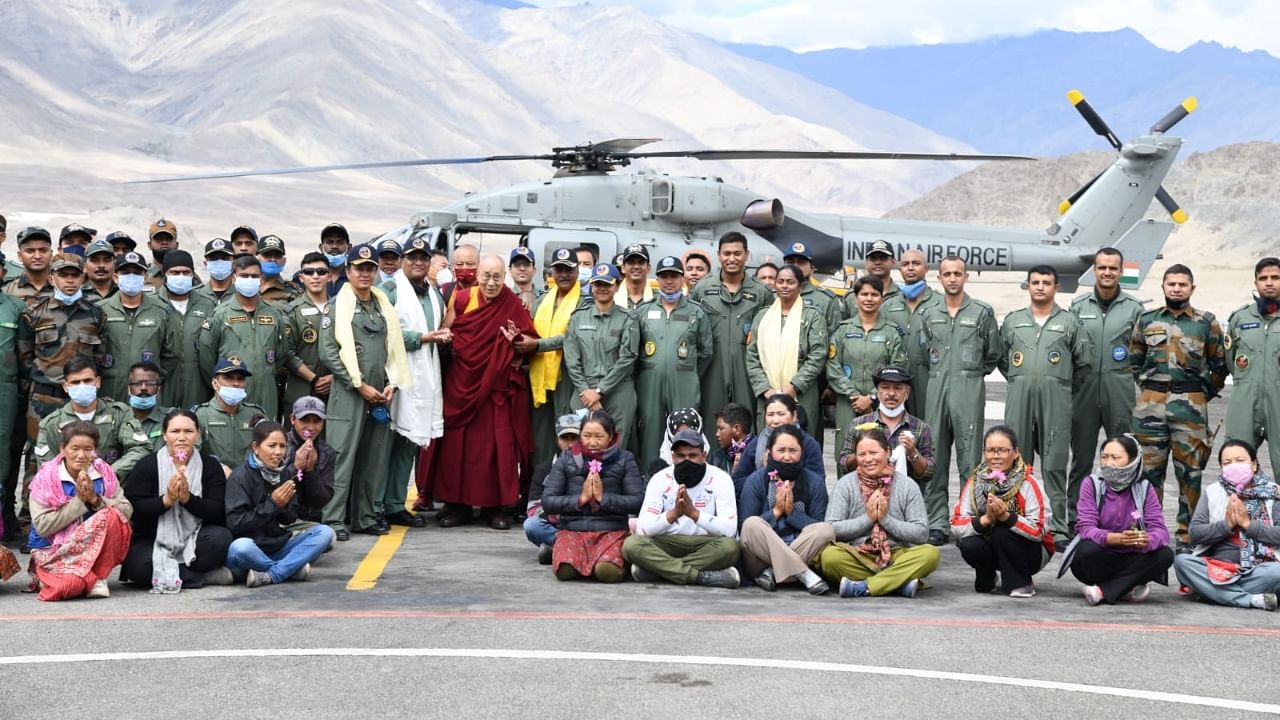
India on Wednesday deployed a military helicopter to fly the 14th Dalai Lama from Leh to a remote village amid its continuing stand-off with China along the Line of Actual Control between the two neighbouring nations in eastern Ladakh.
The 14th Dalai Lama flew onboard an indigenously developed Dhruv Advanced Light Helicopter of the Indian Air Force (IAF) from Leh to a 15th century monastery near Lingshed, one of the remotest villages of the Union Territory of Ladakh. He had reached Leh on July 15 last for a month-long visit to Ladakh – his first outside the seat of the Tibetan Government-in-Exile (TGiE) at Dharamshala in northern India after the onset of the Covid-19 pandemic. The global icon of the decades-long struggle of the Tibetans against the Chinese rule over their homeland was received by the Air Commodore P K Srivastava, Air Officer Commanding of the IAF station in Leh, on his arrival at the station for flying to Lingshed.
New Delhi released pictures of the Dalai Lama with the IAF officials and personnel, apparently to tacitly snub China, which in the past repeatedly conveyed its displeasure over the Government of India facilitating the visits of the Tibetan Buddhist monk.
The latest move by Prime Minister Narendra Modi’s government in New Delhi to send out a subtle-but-firm message to Beijing came just days after the Speaker of the United States House of Representative Nancy Pelosi visited Taipei, defying repeated warnings from China, which responded by launching a week-long military drill across the Taiwan Strait.
Beijing considers Tibet and Taiwan as its “core issues” and repeatedly stressed that its sovereignty on both is non-negotiable.
The Dalai Lama recently said in Leh that a change in the situation in China was imminent and the exiled Tibetans should remain strong. “Times are changing and truth will prevail. There are indications that things will change for the better in China before long. Therefore, please remain strong and preserve your sense of brotherhood and sisterhood,” he said, addressing a congregation of nearly 6500 Tibetans in the outskirts of Leh on Sunday.
“His Holiness @DalaiLama flew in an IAF Dhruv helicopter from Air Force Station Leh to Lingshet. He was received by Air Cmde P K Srivastava, Leh. His Holiness showered his blessings on all air warriors of the station,” a spokesperson of the Ministry of Defence of the Government of India posted on Twitter on Wednesday. He also posted a picture of the Dalai Lama along with the IAF officials and personnel as well as the local Tibetans.
The 87-year-old Tibetan spiritual leader presided over the closing ceremony of the 10-day-long Ladakh Ling-Gon Yarchos Chenmo festival at Lingshed. Apart from the Tibetan Buddhists, the ceremony was also attended by representatives of Muslim and Christian communities of Ladakh. The monk also led a teaching session on Tibetan Buddhism to a large number of villagers gathered on the ground in front of the monastery.
The Dalai Lama had earlier on July 24 visited not only Jokhang Buddhist temple in Leh, but also the Jama Masjid and the Moravian Church in the capital of Ladakh.
The visit by the Tibetan Buddhist monk is also his first one to Leh since the military stand-off between India and China started along the Line of Actual Control (LAC) in eastern Ladakh in April-May 2020. Prime Minister Narendra Modi’s phone-call to the Dalai Lama on his 87th birthday last week irked Beijing, prompting it to ask New Delhi to refrain from using the issue of Tibet to interfere in the internal affairs of China. New Delhi responded by underlining that it was a consistent policy of the Government of India to treat the Dalai Lama as an honoured guest in the country.
The Dalai Lama has been living in India ever since he fled the Potala Palace in Lhasa in March, 1959, to escape the Chinese PLA, which had by then occupied Tibet. He has been a staunch advocate for non-violence and freedom, and was awarded the Nobel Peace Prize in 1989. He has been demanding “genuine autonomy” – not independence from Chinese Government’s rule – for Tibet. Beijing, however, still calls him a “separatist” and accuses him of running a campaign to split China.
The Chinese Government had in the past repeatedly asked New Delhi to shut down the Tibetan Government in Exile based in India.
